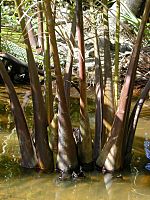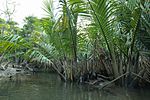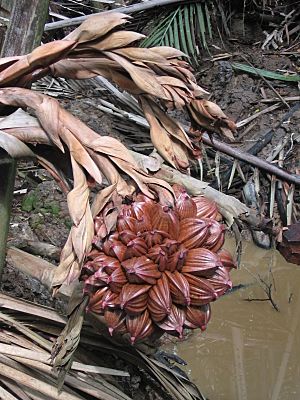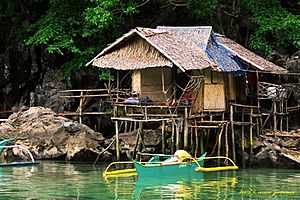Nipa palm facts for kids
The nipa palm, also known as the mangrove palm, is a special type of palm tree. It grows along coastlines and in river mouths in the Indian and Pacific Oceans. What makes it unique is that it's the only palm tree that can live in a mangrove habitat. It's the only species in its group, making it very distinct!
Quick facts for kids Nipa palm |
|
|---|---|
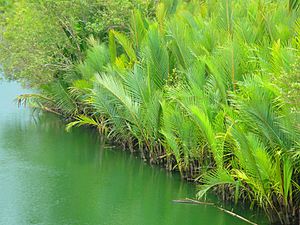 |
|
| Nipa palms in Bohol, Philippines | |
| Conservation status | |
| Scientific classification | |
| Genus: |
Nypa
|
| Species: |
fruticans
|
Contents
What the Nipa Palm Looks Like
The nipa palm is quite unusual! Its main trunk grows hidden beneath the ground, in the mud. Only its large leaves and flower stalks reach up above the water. These leaves can grow very tall, up to 9 meters (30 feet) high!
The flowers of the nipa palm grow in a round shape. At the very top are the female flowers. Below them are red or yellow male flowers that look a bit like catkins. After flowering, the palm produces woody nuts. These nuts are grouped together in a round cluster, about 25 cm (10 inches) wide, on a single stalk. When the nuts are ripe, they break off and float away on the tide. Sometimes, they even start to sprout while still floating in the water!
Where Nipa Palms Grow
Nipa palms love to grow in soft mud where the water moves slowly. They thrive in tidal areas and rivers that bring in lots of nutrients. You can find these palms as far inland as the tide can carry their floating nuts.
They are common along the coasts and rivers that flow into the Indian and Pacific Oceans. This includes places from India all the way to the Pacific Islands. The nipa palm can survive if its environment occasionally dries out for a short time.
Even though it's called the "mangrove palm," it doesn't like pure seawater too much. It prefers brackish water, which is a mix of fresh and salt water, often found in estuaries (where rivers meet the sea).
Nipa palms are native to many countries. These include China (Hainan), the Ryukyu Islands of Japan, Bangladesh, India, Sri Lanka, Myanmar, Thailand, Vietnam, Malaysia, the Philippines, Indonesia, Papua New Guinea, and parts of Australia like Queensland and the Northern Territory. They have also started growing naturally in places like Nigeria, Panama, and Trinidad.
The northernmost place where nipa palms grow is Japan's Iriomote Island and its nearby Uchibanari Island.
How People Use Nipa Palms
The long, feathery leaves of the nipa palm are very useful for local people. They are often used as roofing material for thatched houses or simple homes. These leaves are also used to make many types of baskets. In Burma, large stems of the nipa palm are used to help people learn to swim because they have good buoyancy (they float well).
On the islands of Roti and Savu, the sweet sap from nipa palms is given to pigs during the dry season. People say this makes the pork taste sweeter! The young leaves are also used to wrap tobacco for smoking.
In Cambodia, the palm is called cha:k. Its leaves are used to cover roofs. In Papua New Guinea, the leaf stems are used for house walls, and the small leaflets for decorations. The thin outer layer of the leaves can even be used as cigarette papers.
Food and Drinks from Nipa Palms
The nipa palm's flower cluster can be "tapped" to get a sweet, edible sap. This sap is collected to make local alcoholic beverages like tuba in the Philippines and Malaysia. To get the sap, the flower cluster is cut, and mud is rubbed on the stalk to help the sap flow. A bamboo tube or bottle is placed over the cut stalk to collect the sap twice a day. A small slice is cut off the stalk each time to keep the sap flowing. Sap can flow for about 30 days from one stalk, and nipa palms flower all year, so there's always sap available!
Tuba can be stored for several weeks to make a type of vinegar. This vinegar is known as sukang paombong in the Philippines and cuka nipah in Malaysia. Tuba can also be distilled (heated to separate the alcohol) to make a stronger drink called arrack. In the Philippines, it's called lambanog, and in Indonesia, it's arak.
Young nipa palm shoots can be eaten, and the flower petals can be used to make a fragrant tea. The immature fruits, called attap chee, are sweet, clear, and jelly-like. They are a byproduct of sap harvesting and are used in desserts in Thailand, Malaysia, the Philippines, and Singapore.
In Indonesia, especially in Java and Bali, the sap is also used to make a type of Jaggery (a traditional unrefined sugar) called gula nipah. In Sarawak, it's called gula apong. In Thailand, the leaves are used for desserts. In Cambodia, the leaves are used to wrap cakes, and the flowers are sometimes used for sugar, vinegar, and alcohol.
Nipa Palm as Biofuel
The nipa palm produces a lot of sugar-rich sap. This sap can be fermented into ethanol or butanol, which are types of fuel. A nipa palm grove can produce a huge amount of fuel per year, much more than sugarcane or corn (maize).
One great thing about nipa palm sap is that it needs very little fossil fuel energy to produce once the grove is established. It also doesn't need arable land (land suitable for growing crops), and it can use brackish water instead of fresh water. Unlike most energy crops, the nipa palm doesn't take away from food production to make fuel. In fact, since nipa fruit is a natural part of sap production, it provides both food and fuel at the same time!
Nipa Palm Fossils
Today, there is only one type of Nypa palm, N. fruticans, which grows from Australia up to China. But long, long ago, during a time called the Eocene (about 56 to 33.4 million years ago), the Nypa palm grew almost all over the world!
Scientists have found fossil mangrove palm pollen in India that is 70 million years old. They have also found fossil fruits and seeds of Nypa in Egypt.
Fossilized nuts of Nypa from the Eocene period have been found in England, in places like Branksome, Dorset and the Isle of Sheppey. A fossil species, N. australis, was found in Tasmania. Fossils of Nypa have also been found in North and South America, dating back to the Cretaceous period.
Scientists believe that where Nypa fossils are found, the climate was likely tropical with seasonal rainfall, similar to where they grow today. The fact that Nypa fossils are found worldwide from the Eocene period, even in places that are now cold, helps prove that the Eocene was a time when the Earth was much warmer globally, before the modern polar ice caps formed.
See also
 In Spanish: Nypa fruticans para niños
In Spanish: Nypa fruticans para niños



